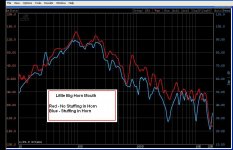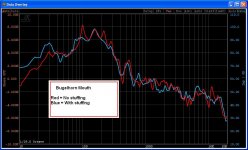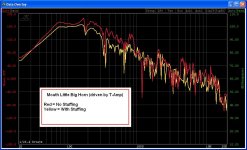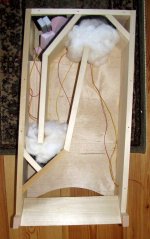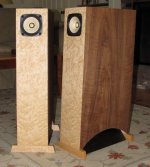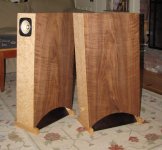The peak shows up in the same place with the bugelhorns also. I think the position is a function of horn length and since they are about the same length it shows up in the same place. Both horns are about 1.6m which is about 1/2 wavelength at 100hz. I think it may be caused by the difference between theoretical and actual coupling to the room at the mouth. Maybe a mismatch is causing a reflection which shows up as the peak at 100hz.
It will be interesting to compare with chuyler1's frugelhorn when we get together.
It will be interesting to compare with chuyler1's frugelhorn when we get together.
Did you try putting some loose fibre stuffing in the horn to see if it will damp that peak? Worked for my Sachikos...takes a bit of effort to get the amount right and I was limited about where I could put it as I couldn't get past the first or last fold from either the mouth or from behind the driver.
-- Andrew
-- Andrew
I've got some 1/4 felt in back of the driver and in two bends but it didn't make a difference. I think 100hz is too low for a bit of felt to help much.
Also try taking some measurements in a different room, or perhaps outside. You want to rule out any room-related issues regarding your box design. It won't help you in the end, but it will help us make a decision as to whether we should try the project in our own rooms 🙂
Well, hmmm, that's a little blunt, nevertheless, given you have such a nice design I think its worth following it through to see if it can be made to live up t its potential.
Best of luck,
-- Andrew
Best of luck,
-- Andrew
Well, AndrewL it worked! I had some nylon fiber stuffing around and tried one small handful and noticed a small difference then tried two small handfuls in different point on the expansion and it made a huge difference (see attached plot). It cut the 100hz peak down 7-8db and also reduced the rest of the ripple also. On the downside, it also cut down the level at 40hz a few db also. It seems like a good trade.
Thanks!
Denis
Thanks!
Denis
Attachments
Seems to have dropped the output quite a bit across the board, but it did a nice job getting rid of that 100Hz peak. Do you notice a difference in how they sound?
Great, glad it worked out. Don't thank me, however, thank Martin King, and Scottmoose, Dave D and others.
From what I have learnt, you have, in simple terms (that goes for most physically acceptable horns, i.e. ones we can live with size wise) created a combination of a horn and a transmisson line, this seems inevitable when we try and create something that is compact but still a horn, its fizzics as an old school chum would say.
The fibre damps the TL action, I think, I'm still learning, of course you loose a bit of sensitivity but the gains seem to be worth it as it reduces ripple and gets rid of the low bass peaks.
-- Andrew
From what I have learnt, you have, in simple terms (that goes for most physically acceptable horns, i.e. ones we can live with size wise) created a combination of a horn and a transmisson line, this seems inevitable when we try and create something that is compact but still a horn, its fizzics as an old school chum would say.
The fibre damps the TL action, I think, I'm still learning, of course you loose a bit of sensitivity but the gains seem to be worth it as it reduces ripple and gets rid of the low bass peaks.
-- Andrew
I'm not sure the absolute levels of the two runs are directly comparable. Small changes in the position of the mike from run to run can easily make a db or two difference. Here is the same plot with the "stuffed line" shifted up two db to better match up. You can better tell exactly what was chopped off.
Attachments
Would the Frugelhorn v1 benefit from this treatment? ...figured I'd ask before I tell my wife we need to pick up some new pillows. 🙂
I reached in through the mouth and placed a loose handful into the last elbow. I placed a second handful a little closer to th mouth but still ~two feet from the end.
Based on some comments in the eNABL thread it appears that the output impedance of my measuring setup was giving anomalous results. I've since added a T-Amp to driver the speaker. It appears it was this problem that caused the 100hz peak I mentioned in previous posts.
Here is the mouth data with and without stuffing. You can see that, even without stuffing, the 100 hz peak is gone. The stuffing reduces the rest of the ripple as well as reducing overall mouth levels by 2-3 db.
Here is the mouth data with and without stuffing. You can see that, even without stuffing, the 100 hz peak is gone. The stuffing reduces the rest of the ripple as well as reducing overall mouth levels by 2-3 db.
Attachments
- Status
- Not open for further replies.
- Home
- Loudspeakers
- Full Range
- Little Big Horn
